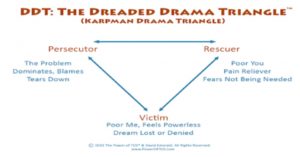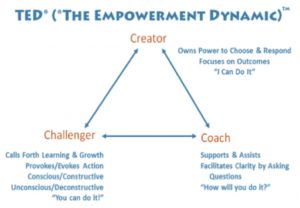Addiction & Recovery – Codependency
Tips and coping strategies from week 1 of the Addiction Recovery workshop with therapist Nicki Line.
Codependency: The Drama Triangle

Victim; The stance of the victim is “poor me”. Victims see themselves as victimized or powerless. They can deny responsibility for their negative circumstances and deny possession of the power to change those circumstances. A person in the victim role will look for a rescuer to save them (and if someone refuses or fails to do that they may perceive them now as a persecutor.) Victims typically have difficulties making decision, solving problems, or understanding their self-defeating behaviors.
Rescuer: The stance of the rescuer is “let me help you!”. Rescuers work hard to take care of other people. Rescuers may need the help of other people to feel good about themselves, while neglecting their own needs. Rescuers are codependent in terms of needing a victim to help, and they can often feel guilty or badly about themselves if they are not actively rescuing someone. Rescuers are also considered enablers because they remove responsibility from the victim to manage their own problems. Rescuers can find themselves overworked, burnt out, and often can begin to feel resentment festering. Often this resentment can shift a rescuer into the role of a persecutor as they feel/ express things such as “ You don’t care about anything I do for you and you never do anything for me!”.
Persecutor: The stance of the persecutor is “it’s all your fault!”. Persecutors often criticize and blame the victim. Persecutors may use threats and criticism to keep a victim feeling oppressed. However, their criticism usually does not help or solve any problems.
* In a codependent situation, an individual can play all three of these roles at different points in time.
Codependency: The Empowerment Dynamic (TED)

The empowerment dynamic is the positive alternative to the drama triangle
Creator: Alternative to the victim. A creator is focused on a desired outcome, and sets goals that propel them towards their desired outcome.
Coach: Alternative to the rescuer. Uses compassion and questions to help guide a creator to developing their own vision and plan of action. Instead of stepping in and taking over as a rescuer may, a coach uses encouragement and support to help a creator put their plans into action.
Challenger: Alternative to the persecutor. A challenger is focused on learning and growth. They hold a creator accountable, but consciously builds them up and encourages them to keep moving and stay accountable to their goals.
Self Soothe Kits
Try to include something that engages each of the five senses. Some examples:
Sight: A postcard of somewhere you feel calm/ safe or somewhere you’ve always wanted to go. Photos of your favorite people. Affirmation cards.
Touch: slime or silly putty
Sound: a playlist on your phone with calming music
Taste: chocolate, citrus tastes, sour candies.
Smell: scented lotion or oils
Grounding Exercises
54321 Technique:
- Acknowledge 5 things you can see
- Acknowledge 4 things you can touch
- Acknowledge 3 things that you can hear
- Acknowledge 2 things that you can smell
- Recite 1 thing positive about yourself.
.
Breathing Exercise
Square breathing:
- Slowly exhale all your air
- Gently inhale through your nose to a slow count of 4
- Hold in for a count of 4
- Gently exhale through your mouth to a slow count of 4
- Pause and hold for a count of 4
- Repeat
Useful Resources
The power of TED -Book by David Emerald Womeldorff
Brene Brown The Call To Courage- Netflix special
Brene Brown various Ted Talks about vulnerability – available on YouTube
The Body Keeps the Score- book by Bessel van der Kolk












